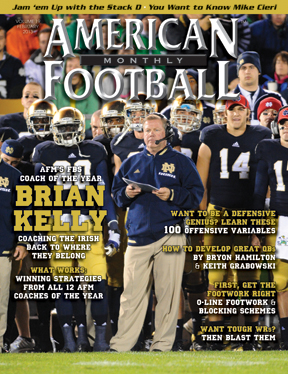Article CategoriesAFM Magazine
|
Safety First – Training for Safetyby: Mike CarrollHead Athletic Trainer, Stephenville High School (TX) © More from this issue Vince Lombardi once said, “Football is not a contact sport. Football is a collision sport. Dancing is a contact sport.” This, coupled with the fact that every year, athletes at all levels are getting bigger, stronger, and faster, means that there is a very real threat to see a dramatic increase in football injuries. These run the gamut from minor injuries with no time lost to more severe injuries that could be season or career ending. Keeping a football team healthy is very often one of the keys to success. If the top players can stay on the field, the respective coach has the best chance for his team to compete at the level they are capable of playing. To do this, the school must establish recommendations for the prevention, care and management of athletic related injury and illness. The individual who is best suited for this is the certified athletic trainer. Certified athletic trainers’ educational background is in injury prevention, care, and treatment. If a school has football, it should have an athletic trainer available – not only for games, but for practices as well. Because a majority of injuries occur during practice, this medical professional should be readily available to evaluate athletes’ injuries. Athletic trainers maintain continuing education and professional development. Although football coaches should be trained in first aid, CPR, and AED use, that does not negate the fact that a school should have an athletic trainer available for all practices and games. Athletic trainers are educated and trained to determine an individual’s readiness to participate. If an individual is not physically ready and able to participate, he should not be on the football field. The athletic trainer also promotes safe and appropriate practices, competitions, and maintains the treatment facility. Often, the coaching staff selects and fits the players’ athletic equipment. The athletic trainer can help with this by advising the staff and also ensuring proper fit once the season commences. The emergency action plan is a critical component to athletic programs. It helps ensure the safety of all participants (players, coaches, and spectators). Without a solid plan in place before an injury occurs, taking care of someone during an emergency situation can become very complicated. Athletic trainers are trained to develop and implement such plans. Another topic that has recently gained a tremendous amount of interest from the media and, in turn, state associations, is environmental conditions. For example, high school activity associations in the states of Georgia and Texas have recently changed their pre-season practice guidelines to make the initial stages of the season as safe as possible for athletes. Monitoring environmental conditions during pre-season practices is also a responsibility of the athletic trainer. He or she can ensure all players are properly hydrated and constantly monitor them. Deaths from heat illness are 100% preventable. The presence of an athletic trainer will help to keep all athletes safe in their practice sessions. Football players get injured during the course of preparing for and playing football. That is the nature of the game. It is critical that strategies exist for prevention of these injuries. This is another area where the athletic trainer has an extensive background. Not every athlete who becomes injured has to go to a medical doctor. The athletic trainer can assess and, very often, treat an injury with negligible down time. With an on-campus athletic trainer, an ankle injury that may have required a doctor visit and several additional visits to a physical therapist can be dealt with at the school with minimal to no loss of school time. Finally, there are also other areas in which athletic trainers are trained. The psychosocial aspect of return from an injury is very often overlooked, but it is very important for the athlete to participate at a high level. Nutritional counseling is also very important because a properly fueled athlete is critical. Access to an athletic trainer ensures athletes can benefit from their expertise in this area. As we all know, any football program that wants to play at the highest level and achieve its maximum potential must have several critical components. It must have players who can and are willing to do what is asked of them. It must have a coaching staff that is willing and able to do whatever is needed to prepare players for games. And it must have a tremendous support staff. In that support staff, it is critical to have an individual who can develop and implement a comprehensive program and administrative system to deal with athletic injuries. That person is the certified athletic trainer. If a school can afford to have a football program, it should find a way to afford an athletic trainer. Whether an athlete is facing a life threatening condition, a concussion, or a minor injury, the person who is most qualified to deal with all of these situations is the certified athletic trainer. |
|
| HOME |
MAGAZINE |
SUBSCRIBE | ONLINE COLUMNISTS | COACHING VIDEOS |
Copyright 2025, AmericanFootballMonthly.com
All Rights Reserved




